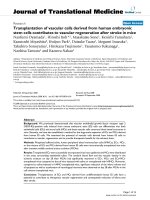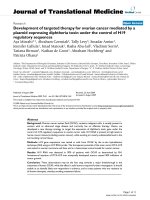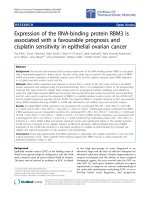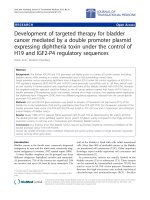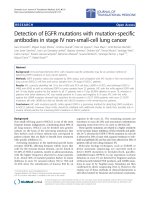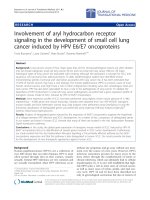báo cáo hóa học:" Sensitization of ovarian cancer cells to cisplatin by genistein: the role of NF-kappaB" doc
Bạn đang xem bản rút gọn của tài liệu. Xem và tải ngay bản đầy đủ của tài liệu tại đây (1.49 MB, 11 trang )
BioMed Central
Page 1 of 11
(page number not for citation purposes)
Journal of Ovarian Research
Open Access
Research
Sensitization of ovarian cancer cells to cisplatin by genistein: the
role of NF-kappaB
Leigh A Solomon
1
, Shadan Ali
2
, Sanjeev Banerjee
3
, Adnan R Munkarah
4
,
Robert T Morris
1
and Fazlul H Sarkar*
3
Address:
1
Division of Gynecologic Oncology, Karmanos Cancer Center, Wayne State University, Detroit, Michigan, USA,
2
Department of Internal
Medicine, Karmanos Cancer Center, Wayne State University, Detroit, Michigan, USA,
3
Department of Pathology, Karmanos Cancer Center, Wayne
State University, Detroit, Michigan, USA and
4
Division of Gynecologic Oncology, Henry Ford Hospital, Detroit, Michigan, USA
Email: Leigh A Solomon - ; Shadan Ali - ; Sanjeev Banerjee - ;
Adnan R Munkarah - ; Robert T Morris - ; Fazlul H Sarkar* -
* Corresponding author
Abstract
Background: Platinum-resistance (PR) continues to be a major problem in the management of
epithelial ovarian cancer (EOC). Response to various chemotherapeutic agents is poor in patients
deemed PR. Genistein, a soy isoflavone has been shown to enhance the effect of chemotherapy in
prostate and pancreatic cancer cells in vitro and in vivo by reversing chemo-resistance phenotype.
The goal of this study was to investigate the effects of combination therapy with genistein and
cisplatin as well as other cytotoxic conventional chemotherapeutic agents in platinum-sensitive (PS)
and resistant EOC cells.
Methods: The PS human ovarian cancer cell line A2780 and its PR clone C200 cells were
pretreated with genistein, followed by the combination of genistein and either cisplatin, taxotere
or gemcitabine. Cell survival and apoptosis was assessed by MTT and histone-DNA ELISA.
Electrophoretic mobility shift assay (EMSA) was used to evaluate NF-κB DNA binding activity.
Western blot analysis was performed with antibodies to Bcl-2, Bcl-xL, survivin, c-IAP and PARP.
Results: Reduction in cell viability, and corresponding induction of apoptosis was observed with
genistein pretreatment followed by combination treatment with each of the drugs in both cell lines.
The PS cell line was pretreated for 24 hours; in contrast, the PR cell line required 48 hours
pretreatment to achieve a response. The anti-apoptotic genes c-IAP1, Bcl-2, Bcl-xL, survivin and
NF-κB DNA binding activity were all found to be down-regulated in the combination groups.
Conclusion: This study convincingly demonstrated that the current strategy can be translated in
a pre-clinical animal model, and thus it should stimulate future clinical trial for the treatment of
drug-resistant ovarian cancer.
Background
There will be an estimated 15,520 deaths from ovarian
carcinoma and 21,650 new cases diagnosed in 2008 [1].
Unfortunately, at the time of diagnosis the majority of
patients will have disseminated disease. Resistance to
platinum-containing regimens and tumor heterogeneity
Published: 24 November 2008
Journal of Ovarian Research 2008, 1:9 doi:10.1186/1757-2215-1-9
Received: 30 October 2008
Accepted: 24 November 2008
This article is available from: />© 2008 Solomon et al; licensee BioMed Central Ltd.
This is an Open Access article distributed under the terms of the Creative Commons Attribution License ( />),
which permits unrestricted use, distribution, and reproduction in any medium, provided the original work is properly cited.
Journal of Ovarian Research 2008, 1:9 />Page 2 of 11
(page number not for citation purposes)
confers a poor prognosis in patients with epithelial ovar-
ian cancer. Platinum-resistance is a complex issue and is
currently believed to be associated with an unstable phe-
notype of ovarian cancer cells that are believed to be
altered by tumor microenvironment and exposure to
other drugs [2,3]. Acquisition of chemo-resistance is one
of the major limitations for the use of platinum com-
plexes in cancer chemotherapy. Proposed mechanisms of
cellular resistance include decreased cellular uptake of the
toxic drug, increased cell efflux of the drug, improved cell
DNA damage repair and the prevention of DNA cross-
linking. These may be intrinsic properties of some cancer
cells or acquired mechanisms due to exposure to chemo-
therapeutic agents.
Over the past few years it has been shown that a small por-
tion of cancer cells known as "cancer stem cells" or "can-
cer stem-like cells" are responsible for the antagonism of
the disease, resistance to therapy, self-renewal and unlim-
ited proliferation in several cancers, including ovarian
cancer [4-7]. Moreover, mutations may be one of the
major factors contributing to the origin of ovarian cancer
stem cells. Emerging evidence suggests that ovarian cancer
stem cells are relatively resistant to conventional cytotoxic
chemotherapeutic agents [8]. These therapies often cause
severe toxicity because of their general effects on all rap-
idly dividing cells. It is important that we use targeted
agents that discriminate between cancer stem cells and
normal stem cells. One such agent which has been studied
in our laboratory and by others is "genistein", a naturally
occurring isoflavone present in soybeans has proven to
have anti-tumor activity with minimal or no toxicity to
nonmalignant human cells [9,10]. Moreover, the inci-
dence of ovarian cancer is approximately 10–50% lower
in Asian countries compared to the United States [11],
which could be associated with dietary factors. Asian
women who migrate to the United States and their
descendents seem to maintain the decreased risk [11]. In
a case control study in Southeast China, Zhang, et al,
found the odds ratio of developing ovarian cancer with a
diet high in genistein to be half that of controls [12], and
suggest that soy isoflavone may contribute to reduced can-
cer risk in Asian population [12].
Studies of various cancer cell lines, in our laboratory and
others, have shown that treatment with the isoflavonoid
genistein can inhibit cell proliferation. In the breast cancer
cell line MDA-MB-231, treatment with genistein affected
cell growth and apoptosis-related gene expression via a
p53 pathway [13]. In some prostate cancer cell lines, gen-
istein treatment leads to inactivation of the nuclear tran-
scription factor Nuclear Factor-kappa B (NF-κB) via the
Akt signaling pathway [14]. Other investigators have
shown that the PTEN gene may also reverse chemo-resist-
ance to cisplatin in ovarian cancer through inactivation of
the PI3K/Akt cell survival pathway and can be a potential
target for the treatment of chemo-resistant cancer [15].
Moreover, genistein also potentiated growth inhibition
and apoptosis in certain pancreatic cancer cells by inhibit-
ing Akt and NF-κB [16]. NF-κB is an important regulator
of genes involved in cell survival and proliferation; it also
plays an important role in the apoptotic pathway [16].
Additionally, tissue transglutaminase, an enzyme
involved in protein cross-linking prevents apoptosis
induced by cisplatin by activating the NF-κB survival path-
way in ovarian tumors [17].
In a recent article it was reported that genistein induces
apoptosis in ovarian cancer via different molecular path-
ways in both wild type and mutated BRCA1 estrogen
receptor positive tumors [18]. Genistein also caused cell
cycle arrest at G2/M phase in both dose- and time-
dependent manner without causing any cytotoxicity [19].
Genistein can also induce both apoptosis and autophagic
cell death in ovarian cancer cells [20]; however the role of
genistein in chemo-resistant ovarian cancer cells has not
been investigated. Therefore, the intent of this study was
to evaluate the effect of genistein for sensitization of ovar-
ian cancer cells to conventional cytotoxic chemotherapeu-
tic agents by assessing the effects of combination
treatments on cell growth, apoptosis and the DNA bind-
ing activity of NF-κB using a paired isogenic cisplatin-sen-
sitive and a cisplatin-resistant ovarian cancer cell line.
Methods
Cells, Drugs and Reagents
Paired isogenic cisplatin-sensitive human ovarian cancer
cell line A2780 and its cisplatin-resistant clone C200 were
received as a generous gift from Dr. Thomas C. Hamilton
of Fox Chase Cancer Center, Philadelphia, PA. They were
maintained in RPMI media supplemented with 10% fetal
bovine serum, insulin and penicillin and streptomycin.
C200 cells were grown with cisplatin (3 μM) every 3 pas-
sages to maintain resistance. Cells were incubated at 37°C
with 5% CO
2
. Taxotere (Aventis Pharmaceuticals, Bridge-
water, NJ), was dissolved in DMSO to make a 4 μM stock
solution. Cisplatin (Sigma) was dissolved in phosphate
buffered saline to make a 1 mM stock solution. Genistein
(Toronto Research Chemicals, Inc, ON, Canada) was dis-
solved in 0.1 M NaHCO
3
to make a 10 mM stock solution.
Cell Viability Assay
Paired cells A2780 and C200 were chosen for this study.
Cells (2–5 × 10
4
) were seeded in a 96-well culture plate
and incubated overnight. Cells were treated with varying
concentrations of genistein (5–25 μM), cisplatin (100–
2000 nM), taxotere (0.5 – 2 nM) and gemcitabine (10–
100 nM) for 48–96 hours. Subsequent experiments were
performed with doses that achieved a 40–60% decrease in
cell viability in the platinum-sensitive cell line. Cells were
Journal of Ovarian Research 2008, 1:9 />Page 3 of 11
(page number not for citation purposes)
pre-treated with genistein for 24 hours followed by com-
bination treatment with genistein and either cisplatin, tax-
otere or gemcitabine for an additional 48 hours. After 72
hours of total treatment, the cells were incubated at 37°C
with 1 mg/mL MTT reagent (Sigma, St. Louis, MO) for 2
hours. The formazan crystals were dissolved in isopropa-
nol. Spectrophotometric absorbance of the samples was
determined by the Ultra Multifunctional Microplate
Reader (Tecan, Durham, NC USA) at 595 nm. When ini-
tial experiments with genistein and cisplatin did not show
a significant effect in the resistant cells (C200), the pre-
treatment interval was increased to 48 hours with genis-
tein alone, followed by 48 hours of combination
treatment and the doses of genistein, gemcitabine and tax-
otere were increased in the C200 cell line.
Quantification of apoptosis by ELISA
The Cell Death Detection ELISA Kit (Roche, Palo Alto, CA
USA) was used for assessing apoptosis in A2780 and C200
cells treated with genistein, cisplatin, taxotere, gemcitab-
ine and their combinations according to the manufac-
turer's protocol. Briefly, A2780 and C200 cells were
treated with 10–25 μM genistein, 250 nM cisplatin, 1–2
nM taxotere and 2–50 nM gemcitabine and the combina-
tion of these drugs for 72 to 96 hours. After treatment, the
cells were trypsinized and 10,000 cells were added to lysis
buffer. The cells were then centrifuged at 20,000 × g for 10
minutes and the supernatant was transferred into anti-his-
tone-coated microtiter plates and incubated at room tem-
perature for 90 minutes. This was followed by anti-DNA-
peroxidase incubation for 90 minutes. After unbound
antibodies were removed, the nucleosomes were quanti-
fied by color development with substrate. The optical den-
sities of the samples were determined by the Ultra
Multifunctional Microplate Reader (Tecan, Durham, NC
USA) at 405 nm.
Protein extraction and Western blot analysis
A2780 and C200 cells were seeded in 100 mm dishes and
allowed to attach for 24 hours. Cells were then treated
with 10–25 μM genistein, 250 nM cisplatin, 1–2 nM tax-
otere and 2–50 nM gemcitabine and the combination of
these drugs for 96 hours to evaluate the effects of treat-
ment on expression levels of survivin, Bcl-2, Bcl-xL, c-
IAP1, and was also used for assessing PARP cleavage, an
indirect measure of apoptosis. The experiment was carried
out for a minimum of three times. Cells were harvested by
scraping from culture plates and collecting by centrifuga-
tion. Cells were resuspended in lysis buffer consisting of
250 mM NaCl, 50 mM Tris buffer (pH 7.5), 5 mM EDTA,
1% NP40, 0.5% sodium deoxycholate, 0.1% SDS, 50 mM
sodium fluoride, 1 mM sodium orthovandate, 1 mM phe-
nylmethylsulfonylfluoride (PMSF), 1 μg/ml pepstatin and
a protein inhibitor which contain a broad spectrum of ser-
ine, cysteine and metalloproteases (Roche Applied Sci-
ence, Indianapolis, IN) for 30 minutes on ice. Cell lysates
were centrifuged for 20 min. Protein concentration was
measured using BCA Protein Assay Kit (Pierce Rockford,
IL). The samples were loaded on 7–12% SDS-PAGE for
separation and electrophoretically transferred to a nitro-
cellulose membrane. Each membrane was incubated with
monoclonal antibody against Survivin (R & D Systems,
Inc. Minneapolis, MN), Bcl-2 (1:200, Calbiochem, San
Diego, CA), Bcl-xL, c-IAP1 (Santa Cruz Biotechnology,
Santa Cruz, CA), PARP (Biomol, Plymouth, CA), and β-
actin (Sigma, St. Louis, MO). Blots were washed with
phosphate buffer containing 0.05% Tween (PBST) and
incubated with secondary antibodies conjugated with per-
oxidase. The signal intensity was then measured using
chemiluminescent detection system (Pierce Rockford, IL).
Electrophoretic Mobility Shift Assay (EMSA) for NF-
κ
B
activation
EMSA was performed using the Odyssey Infrared Imaging
System with NF-κB IRDye labelled oligonucleotide from
LI-COR, INC. (Lincoln, NE). The DNA binding reaction
included 5 μg of the nuclear extract mixed with oligonu-
cleotide and gel shift binding buffer consisting of (20%
glycerol, 5 mM MgCl
2
, 2.5 mM EDTA, 2.5 mM DTT, 250
mM NaCl, 50 mM Tris-HCl pH 7.5, 0.25 mg/ml poly(dI):
poly(dC). The reaction was incubated at room tempera-
ture in dark for 30 minutes. 2 μl of 10× Orange G loading
dye was added to each sample and loaded on the pre-run
8% polyacrylamide gel and ran at 30 mA for 1 hour. NF-
κB p65 antibody was used to confirm the super shift and
the Rb antibody was used for assessing protein loading
control.
Statistical Methods
Comparisons of survival, and apoptosis between the
groups were undertaken by the Student t test. Statistical
significance was assumed for a P value of ≤ 0.05.
Results
Effects of genistein, cisplatin, gemcitabine and taxotere on
the viability of A2780 and C200 ovarian cancer cells
The viability of A2780 and C200 cells treated with genis-
tein (10–25 μM), cisplatin (250 nM), gemcitabine (2 – 50
nM) and taxotere (1–2 nM) were determined by the MTT
assay. The platinum-sensitive A2780 cells were more sen-
sitive to each drug than the platinum-resistant C200 cell
line. Pretreatment of the A2780 cells for 24 hours with 10
μM of genistein followed by the combination treatment
for 48 hours with each conventional chemotherapeutic
agent resulted in a greater and significant inhibition of cell
viability compared to each agent alone. On the other
hand, C200 cells pretreated with higher than 10 μM gen-
istein concentrations for more than 24 hours (48 hours)
followed by combination treatment for additional 48
hours with higher concentration of each conventional
Journal of Ovarian Research 2008, 1:9 />Page 4 of 11
(page number not for citation purposes)
Growth inhibition of human ovarian cancer cell lines A2780 (A) and C200 (B) treated with genistein (Gen), cisplatin (Cis), gem-citabine (Gem), taxotere (Tax) alone and the combination treatments were evaluated by the MTT assayFigure 1
Growth inhibition of human ovarian cancer cell lines A2780 (A) and C200 (B) treated with genistein (Gen), cis-
platin (Cis), gemcitabine (Gem), taxotere (Tax) alone and the combination treatments were evaluated by the
MTT assay. A2780 cells were treated with genistein (10 μM), cisplatin (250 nM), gemcitabine (2 nM) and taxotere (1 nM) and
the combination treatment; and the C200 cells were treated with higher doses of genistein (25 μM), gemcitabine (50 nM) and
doxetaxel (2 nM) as described under Materials and Methods. There was a significant reduction in the overall cell viability of
A2780 and C200 cells treated with the drug combinations compared to cells treated with either drug alone. P values shown
represent comparisons between each drug alone and the combination of both drugs using t-test.
Journal of Ovarian Research 2008, 1:9 />Page 5 of 11
(page number not for citation purposes)
chemotherapeutic agent than what was used for A2780
cells also resulted in a significant inhibition of cell viabil-
ity (Figure 1). Our results showed that genistein can sen-
sitize even the drug-resistant cell line and cause inhibition
of cell viability. Further, to assess whether the loss of over-
all cell viability could also be due to the induction of
apoptotic cell death, we examined the effects of genistein,
cisplatin, gemcitabine and taxotere, and the combination
treatments on apoptotic cell death.
Induction of apoptosis by genistein, cisplatin, gemcitabine
and taxotere in A2780 and C200 ovarian cancer cells
Apoptosis assays were performed using the A2780 and
C200 cell lines to evaluate the mechanism on the inhibi-
tion of cell viability using the Cell Death Detection ELISA.
For the platinum-sensitive A2780 cell line, 24 hours pre-
treatment with 10 μM genistein followed by the combina-
tion treatment with 250 nM cisplatin, 2 nM gemcitabine
and 1 nM taxotere for 48 hours showed a significant
increase in apoptosis compared to either drug alone.
Increasing the pretreatment interval to 48 hours with 25
μM genistein followed by 48 hours of combination treat-
ment with 250 nM cisplatin, 50 nM gemcitabine and 2
nM taxotere for 48 hours also showed a significant
increase in apoptosis compared to either drug alone in
resistant cell line (Figure 2). Subsequently, we sought to
find further evidence of apoptosis, as presented below.
The effects of genistein pretreatment and combination
treatment on molecules related to apoptosis in A2780 and
C200 cells
The mechanisms contributing to the potentiation of
apoptosis by genistein pretreatment and combination
treatment were evaluated in the A2780 and C200 cells.
PARP cleavage was determined in A2780 and C200 cells
that were treated with genistein (25 μM), cisplatin (250
nM), taxotere (2 nM), gemcitabine (50 nM) alone or the
combination treatment of cells pretreated with genistein
(Figure 3). We found significantly increased PARP protein
cleavage product (85 kDa fragment) after 72 h treatment
in A2780 cells (Figure 3). In contrast, C200 cells treated
similarly showed comparatively less intense cleaved PARP
with combination treatment only. The induction of apop-
totic cell death could in part be due to inactivation of
important survival genes; and therefore the expressions of
pro-survival and anti-apoptotic molecules such as sur-
vivin, Bcl-2, Bcl-xL, and c-IAP1, which are transcription-
ally regulated by NF-κB, were also evaluated. Expression
of Bcl-2, Bcl-xL, survivin, and c-IAP1 proteins were signif-
icantly reduced in cells treated with the combination com-
pared to either agent alone in both A2780 and C200 cells.
These results suggest that genistein in combination with
conventional therapeutics could down-regulate key sur-
vival proteins and, in turn, induced apoptotic cell death of
both A2780 and C200 cells. Since we found a greater
degree of down-regulation of survivin, c-IAP1, Bcl-2, Bcl-
xL in cells treated with genistein in combination treat-
ment compared to single agent treatment, we investigated
the effect of each treatment on the DNA binding activity
of NF-κB.
Genistein inhibits NF-
κ
B DNA binding activity
Specifically, the effects of pretreatment followed by the
combination treatment were studied in the context of NF-
κB activation. The treatment of cells with genistein alone
significantly down-regulated the DNA binding activity of
NF-κB in both the cell lines tested. Interestingly, the com-
bination treatment groups demonstrated greater inhibi-
tion of NF-κB compared to the treatment of cells with any
of the drugs alone (Figure 4). These results suggest that the
pretreatment of cells with genistein sensitized ovarian
cancer cells, especially the drug-resistant cells to cisplatin,
taxotere, and gemcitabine induced growth inhibition and
induction of apoptotic cell death, which is believed to be
contributed by the inhibition of survival factors, and inac-
tivation of the DNA binding activity of NF-κB.
Discussion
Experimental drug resistance to platinum based chemo-
therapy is a major challenge for the treatment of human
ovarian cancer. For ovarian cancer, the standard treatment
includes aggressive surgical cytoreduction followed by
combination chemotherapy with platinum and a taxane-
containing regimen. Although the majority of patients
will respond to this therapy, most will recur with chemo-
resistant phenotype, which eventually kills patient. Over-
all, the survival of patients diagnosed with advanced stage
disease remains poor, particularly if the tumor is "plati-
num-resistant" [21-23]. Platinum resistance is defined as
tumor progression during initial treatment with a plati-
num-based combination chemotherapy regimen or recur-
rence within 6 months of completing front line therapy,
and thus is considered intrinsic resistance behavior of
ovarian cancer cells. Tumors and metastases may also
acquire resistance over time mediated by various mecha-
nisms. Platinum resistance in EOC remains a challenge to
effectively treat using currently available second and third
line therapies especially in patients having an overall
response rate of less than 20%, suggesting that overcom-
ing platinum resistance by novel approaches could be use-
ful for improving the overall survival of patients.
The management of patients diagnosed with ovarian can-
cer has not changed significantly in the past two decades
requiring development of additional treatment protocols
for improving overall survival. Emerging evidence suggest
that plant-derived non-toxic agents such as curcumin, and
genistein show a variety of pharmacological effects
[24,25]. Genistein is a naturally occurring isoflavone
present in soybeans that has anticancer properties
Journal of Ovarian Research 2008, 1:9 />Page 6 of 11
(page number not for citation purposes)
Induction of apoptosis in human ovarian cancer cell lines A2780 (A) and C200 (B) treated with genistein (Gen), cisplatin (Cis), gemcitabine (Gem) and taxotere (Tax) alone and the combination treatments were evaluated by the ELISA assayFigure 2
Induction of apoptosis in human ovarian cancer cell lines A2780 (A) and C200 (B) treated with genistein (Gen),
cisplatin (Cis), gemcitabine (Gem) and taxotere (Tax) alone and the combination treatments were evaluated
by the ELISA assay. A2780 cells were treated with genistein (10 μM), cisplatin (250 nM), gemcitabine (2 nM) and taxotere (1
nM) and the combination treatment; and the C200 cells were treated with higher doses of genistein (25 μM), gemcitabine (50
nM) and doxetaxel (2 nM) as described under Materials and Methods. There was a significant potentiation in the induction of
apoptosis observed in A2780 and C200 cells treated with both genistein and the other drugs as compared to cells treated with
either agent alone.
Journal of Ovarian Research 2008, 1:9 />Page 7 of 11
(page number not for citation purposes)
The expression of c-IAP1, Bcl-2, Bcl-xl, survivin and PARP in A2780 and C200 cellsFigure 3
The expression of c-IAP1, Bcl-2, Bcl-xl, survivin and PARP in A2780 and C200 cells. Cells untreated or treated with
10 or 25 μM genistein (Gen), 250 nM cisplatin (Cis), the combination (Gen + Cis), 1 or 2 nM taxotere (Tax), the combination
(Gen + Tax), 2 or 50 nM gemcitabine (Gem) and the combination (Gen + Gem). β-actin antibodies were used as internal con-
trols for equal loading of proteins. Significant down-regulation of c-IAP1, Bcl-2, Bcl-xl, survivin and PARP was observed in
A2780 and C200 cells treated with the combination of genistein and either cisplatin, gemcitabine or taxotere compared to cells
treated with either drug alone.
Journal of Ovarian Research 2008, 1:9 />Page 8 of 11
(page number not for citation purposes)
NF-κB activation in A2780 (A) and C200 (B) human ovarian cancer cellsFigure 4
NF-κB activation in A2780 (A) and C200 (B) human ovarian cancer cells. Supershift assay (C) showed the formation
of bigger complex after addition of anti-NF-κB p65 antibody, resulting in the shift of NF-κB band. Cells untreated or treated
with 10 or 25 μM genistein (Gen), 250 nM cisplatin (Cis), the combination (Gen + Cis), 1 or 2 nM taxotere (Tax), the combi-
nation (Gen + Tax), 2 or 50 nM gemcitabine (Gem) and the combination (Gen + Gem). Retinoblastoma antibodies were used
as internal controls for nuclear protein loading as control. Significant inactivation of NF-κB was observed in A2780 and C200
cells treated with the combination of genistein and either cisplatin, gemcitabine or taxotere compared to cells treated with
either drug alone.
Journal of Ovarian Research 2008, 1:9 />Page 9 of 11
(page number not for citation purposes)
[9,13,16,26]. Therefore, we hypothesized that as in other
cancer cell lines; platinum-resistance could be overcome
in ovarian cancer cells by combining the conventional
chemotherapeutic agents with a non-toxic flavonoid com-
pound, such as genistein.
To test our hypothesis, we sought to assess the efficacy of
genistein, a well tolerated naturally occurring substance,
in combination with commonly used chemotherapeutic
agents in a paired isogenic ovarian cancer cell lines (plati-
num-sensitive:A2780, platinum-resistant:C200). Though
combination therapy was effective in inhibiting cell
growth in the platinum-sensitive cell line, genistein pre-
treatment was required for a response in the platinum-
resistant cell line. The observed inhibition of cell growth
was subsequently correlated with an increase in the induc-
tion of apoptosis. We have further extended our observa-
tions to additional cytotoxic conventional
chemotherapeutic agents such as taxotere and gemcitab-
ine. We found that genistein pretreatment resulted in the
appearance of cleaved PARP under all our experimental
conditions, consistent with the increase in apoptosis. This
finding suggests that genistein could sensitize ovarian
cancer cells to platinum and other conventional chemo-
therapeutic agents-induced apoptotic cell death and these
results are consistent with our previous findings in other
cancer cell lines [9,13,16,26].
Studies have shown that the underlying resistance to
apoptosis is in part due to constitutive activation of NF-κB
in pancreatic cancer [27]. Our results strongly suggest that
the resistance of ovarian cancer cells treated with cisplatin
could in part be also due to the activation of NF-κB and
that the chemo-sensitization could be due to genistein-
induced inactivation of NF-κB signaling, resulting in the
inhibition of cell proliferation and induction of apoptosis
(Figure. 5). Our hypothesis is also supported by the evi-
dence of down-regulation of the important anti-apoptotic
proteins such as Bcl-2, Bcl-xL. survivin and c-IAP2, which
also happens to be the downstream genes of NF-κB. C-
IAP-2 and survivin are members of the anti-apoptotic IAP
(Inhibitors of Apoptosis) family of proteins suppressing
apoptosis and their expression in tumors has been associ-
ated with poor prognosis and increased tumor recurrence
in many tumors. Our findings reveal the expression of
these anti-apoptotic proteins is decreased by genistein,
and is probably driven by NF-κB activation suggesting
another possibility for inhibiting tumor and that NK-κB,
survivin and IAP'S may make an important contribution
to the development of chemo-resistance.
Multiple pathways linked with cisplatin resistance have
been reported by many researchers. A synthetic triterpe-
noid inhibited IL-6-Stat-3 pathway which is one of the key
pathway contributing to drug resistance in ovarian cancer
[3]. Pretreatment of cisplatin resistant ovarian cancer cells
Schematic diagram of potential mechanism of genistein induced chemo-sensitization of ovarian cancer cells to conventional chemo-therapeutic agentsFigure 5
Schematic diagram of potential mechanism of genistein induced chemo-sensitization of ovarian cancer cells to
conventional chemo-therapeutic agents.
Journal of Ovarian Research 2008, 1:9 />Page 10 of 11
(page number not for citation purposes)
with trichostatin, a histone deacetylase inhibitor over-
comes mitochondria-dependent apoptosis by restoring
p73 and Bax expression [22]. A small molecule inhibitor
triethylenetetramine inhibited superoxide dismutase 1
which is over expressed in cisplatin resistant cells by
enhancing the cisplatin sensitivity in the resistant cells
[21]. These findings appear to lend support for our current
observation and as such consistent with the role of genis-
tein in the prevention of cisplatin-induced renal injury in
mice [28], and its biological effects on breast [13], pan-
creas [27,29], and melanoma cells [30], associated with
the inhibition in the translocation of p65 subunit of NF-
κB in the nucleus, which is otherwise increased by the cis-
platin treatment.
Conclusion
In conclusion, the evidence provided by this study lend
strong support for our hypothesis that genistein pre-treat-
ment could overcome drug-resistance in ovarian cancer
cells as documented by increased cell growth inhibition
and the induction of apoptotic cell death. We have also
shown that the genistein mediated chemo-sensitization of
ovarian cancer cells to conventional chemotherapeutic
agents was partly due to inactivation of the DNA binding
activity of NF-κB and its downstream genes. Our results
warrant further pre-clinical and clinical studies for assess-
ing the value of genistein in overcoming drug-resistance in
ovarian cancer in order to improve the overall survival of
patients diagnosed with ovarian cancer especially those
with drug-resistant characteristics.
Competing interests
The authors declare that they have no competing interests.
Authors' contributions
LAS and SA collected data for the study and prepared the
original manuscripts. SB carried out the supershift assay;
ARM and RTM supervised the project. FHS directed the
research. All authors approved the final manuscript.
References
1. Jemal A, Siegel R, Ward E, Hao Y, Xu J, Murray T, et al.: Cancer sta-
tistics, 2008. CA Cancer J Clin 2008, 58:71-96.
2. Lin CT, Lai HC, Lee HY, Lin WH, Chang CC, Chu TY, et al.: Valproic
acid resensitizes cisplatin-resistant ovarian cancer cells. Can-
cer Sci 2008, 99:1218-1226.
3. Duan Z, Ames RY, Ryan M, Hornicek FJ, Mankin H, Seiden MV:
CDDO-Me, a synthetic triterpenoid, inhibits expression of
IL-6 and Stat3 phosphorylation in multi-drug resistant ovar-
ian cancer cells. Cancer Chemother Pharmacol 2008 in press.
4. Al-Hajj M, Wicha MS, ito-Hernandez A, Morrison SJ, Clarke MF: Pro-
spective identification of tumorigenic breast cancer cells.
Proc Natl Acad Sci USA 2003, 100:3983-3988.
5. Matsui W, Huff CA, Wang Q, Malehorn MT, Barber J, Tanhehco Y, et
al.: Characterization of clonogenic multiple myeloma cells.
Blood 2004, 103:2332-2336.
6. Pardal R, Clarke MF, Morrison SJ: Applying the principles of
stem-cell biology to cancer. Nat Rev Cancer 2003, 3:895-902.
7. Reya T, Morrison SJ, Clarke MF, Weissman IL: Stem cells, cancer,
and cancer stem cells. Nature 2001, 414:105-111.
8. Ponnusamy MP, Batra Sk: Ovarian cancer:emerging concept on
cancer stem cells. Journal of Ovarian Research 2008 in press.
9. Li Y, Che M, Bhagat S, Ellis KL, Kucuk O, Doerge DR, et al.: Regula-
tion of gene expression and inhibition of experimental pros-
tate cancer bone metastasis by dietary genistein. Neoplasia
2004, 6:354-363.
10. Tatsuta M, Iishi H, Baba M, Yano H, Uehara H, Nakaizumi A: Atten-
uation by genistein of sodium-chloride-enhanced gastric car-
cinogenesis induced by N-methyl-N'-nitro-N-
nitrosoguanidine in Wistar rats. Int J Cancer 1999, 80:396-399.
11. Herrinton LJ, Stanford JL, Schwartz SM, Weiss NS: Ovarian cancer
incidence among Asian migrants to the United States and
their descendants. J Natl Cancer Inst 1994,
86:1336-1339.
12. Zhang M, Xie X, Lee AH, Binns CW: Soy and isoflavone intake
are associated with reduced risk of ovarian cancer in south-
east china. Nutr Cancer 2004, 49:125-130.
13. Li Y, Upadhyay S, Bhuiyan M, Sarkar FH: Induction of apoptosis in
breast cancer cells MDA-MB-231 by genistein. Oncogene 1999,
18:3166-3172.
14. Davis JN, Kucuk O, Sarkar FH: Genistein inhibits NF-kappa B
activation in prostate cancer cells. Nutr Cancer 1999,
35:167-174.
15. Wu H, Cao Y, Weng D, Xing H, Song X, Zhou J, et al.: Effect of
tumor suppressor gene PTEN on the resistance to cisplatin
in human ovarian cancer cell lines and related mechanisms.
Cancer Lett 2008, 271:260-271.
16. El-Rayes BF, Ali S, Ali IF, Philip PA, Abbruzzese J, Sarkar FH: Poten-
tiation of the effect of erlotinib by genistein in pancreatic
cancer: the role of Akt and nuclear factor-kappaB. Cancer Res
2006, 66:10553-10559.
17. Cao L, Petrusca DN, Satpathy M, Nakshatri H, Petrache I, Matei D:
Tissue transglutaminase protects epithelial ovarian cancer
cells from cisplatin-induced apoptosis by promoting cell sur-
vival signaling. Carcinogenesis 2008, 29:1893-1900.
18. Thasni KA, Rojini G, Rakesh SN, Ratheeshkumar T, Babu MS, Srinivas
G, et al.: Genistein induces apoptosis in ovarian cancer cells
via different molecular pathways depending on Breast Can-
cer Susceptibility gene-1 (BRCA1) status. Eur J Pharmacol 2008,
588:158-164.
19. Choi EJ, Kim T, Lee MS: Pro-apoptotic effect and cytotoxicity of
genistein and genistin in human ovarian cancer SK-OV-3
cells. Life Sci 2007, 80:1403-1408.
20. Gossner G, Choi M, Tan L, Fogoros S, Griffith KA, Kuenker M, et al.:
Genistein-induced apoptosis and autophagocytosis in ovar-
ian cancer cells. Gynecol Oncol 2007, 105:23-30.
21. Brown DP, Chin-Sinex H, Nie B, Mendonca MS, Wang M: Targeting
superoxide dismutase 1 to overcome cisplatin resistance in
human ovarian cancer. Cancer Chemother Pharmacol 2008 in press.
22. Muscolini M, Cianfrocca R, Sajeva A, Mozzetti S, Ferrandina G, Cos-
tanzo A,
et al.: Trichostatin A up-regulates p73 and induces
Bax-dependent apoptosis in cisplatin-resistant ovarian can-
cer cells. Mol Cancer Ther 2008, 7:1410-1419.
23. Qamar L, Davis R, Anwar A, Behbakht K: Protein kinase C inhibi-
tor Go6976 augments caffeine-induced reversal of chemore-
sistance to cis-diamminedichloroplatinum-II (CDDP) in a
human ovarian cancer model. Gynecol Oncol 2008, 110:425-431.
24. Lin YG, Kunnumakkara AB, Nair A, Merritt WM, Han LY, rmaiz-Pena
GN, et al.: Curcumin inhibits tumor growth and angiogenesis
in ovarian carcinoma by targeting the nuclear factor-kappaB
pathway. Clin Cancer Res 2007, 13:3423-3430.
25. Gercel-Taylor C, Feitelson AK, Taylor DD: Inhibitory effect of
genistein and daidzein on ovarian cancer cell growth. Antican-
cer Res 2004, 24:795-800.
26. Li Y, Ahmed F, Ali S, Philip PA, Kucuk O, Sarkar FH: Inactivation of
nuclear factor kappaB by soy isoflavone genistein contrib-
utes to increased apoptosis induced by chemotherapeutic
agents in human cancer cells. Cancer Res 2005, 65:6934-6942.
27. Banerjee S, Zhang Y, Wang Z, Che M, Chiao PJ, Abbruzzese JL, et al.:
In vitro and in vivo molecular evidence of genistein action in
augmenting the efficacy of cisplatin in pancreatic cancer. Int
J Cancer 2007, 120:906-917.
28. Sung MJ, Kim DH, Jung YJ, Kang KP, Lee AS, Lee S, et al.: Genistein
protects the kidney from cisplatin-induced injury. Kidney Int
2008 in press.
29. Mohammad RM, Banerjee S, Li Y, Aboukameel A, Kucuk O, Sarkar
FH: Cisplatin-induced antitumor activity is potentiated by
Publish with BioMed Central and every
scientist can read your work free of charge
"BioMed Central will be the most significant development for
disseminating the results of biomedical research in our lifetime."
Sir Paul Nurse, Cancer Research UK
Your research papers will be:
available free of charge to the entire biomedical community
peer reviewed and published immediately upon acceptance
cited in PubMed and archived on PubMed Central
yours — you keep the copyright
Submit your manuscript here:
/>BioMedcentral
Journal of Ovarian Research 2008, 1:9 />Page 11 of 11
(page number not for citation purposes)
the soy isoflavone genistein in BxPC-3 pancreatic tumor
xenografts. Cancer 2006, 106:1260-1268.
30. Tamura S, Bito T, Ichihashi M, Ueda M: Genistein enhances the
cisplatin-induced inhibition of cell growth and apoptosis in
human malignant melanoma cells. Pigment Cell Res 2003,
16:470-476.
